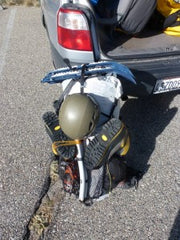Your Cart is Empty
Free shipping on US orders $120 and up (restrictions apply)
Karen at Sage to Summit is tuned in. She keeps track of who is doing what and what they need from the shop. In the fall, while preparing for this now-past ski season, I penned a little article outlining my gear choices. In that article I indicated my lust for a cuben fiber 50l backpack for multi-day ski touring. Innocently enough, we both pictured an average winter of Sierra ski guiding. Karen suggested that I try out Hyperlight Mountain Gear's Windrider 3400 pack for my overnight endeavors. I'd take it out for a couple months, and report back in before the spring ski season really ramped up. Now, I don't need to remind most readers that the Sierra winter of '13-'14 was below average in snow fall. There was certainly skiing to be had, but partners and clients steered clear. As a result, I didn't get out multi-day ski touring until mid April(!).
I did, however, get out on a few multi-day alpine climbing trips, and the aforementioned classic multi-day ski tour to Mt. Lyell. In these couple weeks of usage, I learned a fair amount about the Windrider pack. And I like what I learned. In short, this is an excellent, comfortable pack that happens to be ultralight. Like many of the brands that Sage to Summit carries, Hyperlight Mountain Gear is a small, "cottage" manufacturer. HMG makes their packs, shelters, and accessories in a small factory in small-town Maine. As a graduate of the University of Maine, I have a soft spot in my heart for the people and businesses there. As an enthusiastic mountain traveler, I have a soft spot for excellent equipment. Whether this particular pack were made by hand in a small town in a groovy state, or slammed out of a mega factory thousands of miles from the nearest mountains, I would love the Windrider.
HMG makes a series of packs. Available in four capacities, up to four torso lengths, and with a few different combinations of straps and accessory pockets, their pack series has something for everyone, without being too complicated or confusing. In short, most of what I learned about the Windrider 3400 can be extrapolated to the other sizes and configurations available. (In fact, as a result of my experience with the tested pack, I have purchased myself the next size up in the "Ice" configuration for colder Alaska climbing and ski touring). All of the HMG packs are made of the same ultralight, waterproof, and quite durable cuben fiber fabric. The nature of this fabric means that it won't take dye, so all of the packs are white. The fabric is strong in tension and resists abrasion ok. It is thin and a little vulnerable to puncturing and cutting, as compared to standard nylon. The thin fabric, however, is nothing that normal care cannot protect. My only issue with the pack's durability came when I tried to force my snow saw down the inside of a tightly stuffed load. The short resulting tear was entirely my fault, and shows no signs of spreading. In the end, I have no problem using cuben fiber packs for snowy and icy endeavors, as well as for non-technical walking. When the going gets technical and rocky, however, I turn to similarly simple backpacks constructed from thick and beefy nylon. In that application, nylon resists abrasion better.

Three of the four capacities of HMG packs come with removable, customizable aluminum stays. I love frameless packs and have used this style under loads up to 80 lbs and for weeks at a time. After a short test with them, I immediately removed the stays of the Windrider pack. I basically never traveled in the mountains with the "frame" in. A thin sheet of foam is sewn into the back panel of the Windrider to protect you from pointy things. Your sleeping pad can be placed alongside your back for further protection and support. My short trial with the stays indicated a little bit more support, most noticeably, and ironically, when the pack is less full. A tightly stuffed frameless pack becomes its own rigidity, and again I've never had trouble without metal support. Whether leaving the stays in or removing them, ultralight packs must be packed carefully and fit well. The initial design and contours must be subtly, but crucially shaped to direct the load to the hiker or skier's hips. Few mass produced frameless packs seem to get this right. However, HMG nails it. Even under up to 50lb loads, the Windrider directed the force onto my hips and kept it close and stable for skiing, climbing, and rough walking.
Beyond the primary considerations, the Windrider comes with a modest selection of features and pockets. The top closes in a "roll-top" style. This makes it more weather resistant, and leaves things clean and simple when closed, but it makes for a little slower opening and closing, as compared to a drawstring arrangement. Inside there is a simple mesh "hydration system" pocket. On the outside are three large mesh pockets. One can store quite a bit of gear in these pockets. Carried on the outside, especially in snowy conditions and foul weather, your gear is a little vulnerable to the elements. Also, these mesh pockets don't "look the part" for your normal ski or climbing pack. Normally a feature reserved for trekking packs and outings, the mesh pockets look a little funny on a technical trip. Now, this is totally preposterous, but a point worth addressing. I found the pockets to be quite useful, but did have to "get over" the fact that the Windrider doesn't look like your normal climbing pack. I know, I know, vanity bites. But it's real. You'll feel it too. You'll say, "I can't use that pack for skiing". But you can. Get over it; the mesh pockets are handy. Finally, in addition to a minimal selection of compression straps, the Windrider has small zipped pockets on the waist belt. Store your camera in one, some snacks in the other, and a water bottle in the back mesh pockets and you should be all set for continuous motion.

Fit, weight, and durability are the primary criteria by which I assess a backpack. As summarized above, the Windrider is great in these categories. Even better, the overall construction strikes a balance between these three criteria. The fabric is light, and the construction is simple. The heaviest and bulkiest parts are definitely the waist belt and shoulder straps- as they should be. The bag itself is contoured to fit the body, but otherwise just a simple sack. The features are carefully tailored and remain ultra light. You will like this pack, whether your pursuit is snowy and icy alpine climbing, multi-day ski touring, or long-distance fast packing.
Comments will be approved before showing up.
